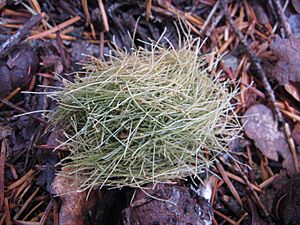Red tree vole facts for kids
Quick facts for kids Red tree vole |
|
|---|---|
 |
|
| Conservation status | |
| Scientific classification | |
| Genus: |
Arborimus
|
| Species: |
longicaudus
|
The red tree vole (Arborimus longicaudus) is a small rodent that lives in the Pacific Northwest region of the United States. You can find them in the states of Oregon and California. They used to be called Phenacomys longicaudus and sometimes people called them the red tree mouse. These tiny creatures are special because they spend almost their whole lives high up in trees!
Contents
Discover the Red Tree Vole
The red tree vole is a type of rodent that belongs to the family Cricetidae. They live only in the coastal forests of Oregon and northern California. These voles eat only the needles from conifer trees. Their favorite food is Douglas-fir (Pseudotsuga menziesii) needles. Sometimes, they also eat needles from western hemlock (Tsuga heterophylla), Sitka spruce (Picea sitchensis), grand fir (Abies grandis), and Bishop pine (Pinus muricata).
Red tree voles are about 6 to 8 inches (15-20 cm) long, including their tail. When they are young, their fur is a dull brown color. As they get older, their fur turns a more reddish color. They are active mostly at night, which means they are nocturnal. This makes them very hard to spot. However, you can often find piles of tiny resin ducts on the ground. These are like small, discarded bits from the needles they eat.
Homes and Nests of the Red Tree Vole
Red tree voles live almost entirely in Douglas-fir trees. Sometimes, they are found in Sitka spruce and western hemlock trees. They might spend their whole lives in just one tree. In very large trees with many branches, several generations of voles can live in different parts of the same tree.
Red tree voles usually have a home area of about 800 square meters (about 8,600 square feet). This area can be smaller in older forests and larger in younger forests. Within this home area, they might have nests in up to six different trees. However, females usually have two nests, and males average three nests.
How Red Tree Voles Build Nests
When red tree voles eat Douglas-fir needles, they carefully remove tiny resin ducts. These ducts look like thin, straight hairs along the edges of the needles. These resin ducts then become a main part of their nests. Besides these ducts, their nests are also made of small Douglas-fir cuttings and their own droppings.
These nests are often built on or inside large branches. They can also be found in broken tree tops, hollow spaces, or split trunks. The nests are always located within the living, green part of the tree's crown.
Red Tree Vole Life Cycle
Both male and female red tree voles build nests. However, the nests built by mothers are much larger.
Reproduction and Young Voles
Red tree voles have small litters, meaning they have only 1 to 4 babies at a time. Their pregnancy period is about 28 days, which is quite long compared to other small rodents. Young voles depend on their mothers for a long time, usually 47 to 60 days, before they can live on their own.
Female voles can get pregnant again just a few days after giving birth. This means it is common to find two different groups of babies living in the same nest. During the busiest breeding times, which are winter and spring, male voles travel longer distances to find females. Female voles tend to stay closer to their nests, so their home areas are smaller.
Predators of the Red Tree Vole
The northern spotted owl is one of the main animals that hunts and eats red tree voles. Recent studies also show that short-tailed weasels are another important predator of the red tree vole.
Female voles are easier for predators to find because their nests are larger. They also spend more time outside their nests looking for food to bring back for their young. This extra time outside makes them more likely to be caught by predators.
Protecting Red Tree Voles
The places where red tree voles live, especially old forests, are becoming a concern for the species. Cutting down trees (logging) and breaking up their natural homes (habitat fragmentation) have made them vulnerable. This means they are at risk on the list of sensitive species along the Oregon coast.
Red tree voles are especially at risk from timber harvesting because they live in trees. Their slow reproduction rates also add to concerns that the species could become even more threatened. They are an important food source for the threatened Northern Spotted Owl. Because of this, they have been listed as a "survey and manage species" under the Northwest Forest Plan (NWFP). This plan helps to manage the ecosystem in their area.



